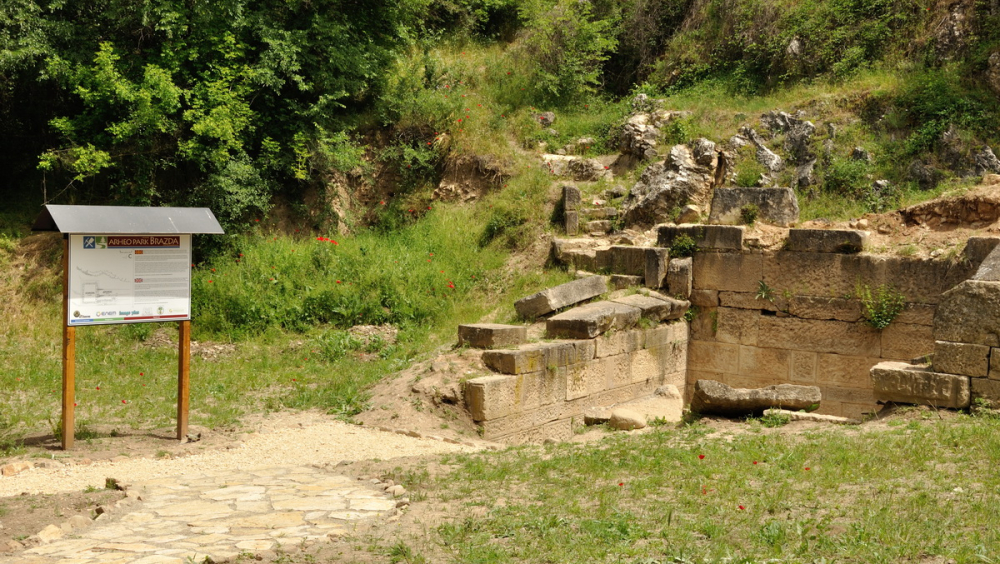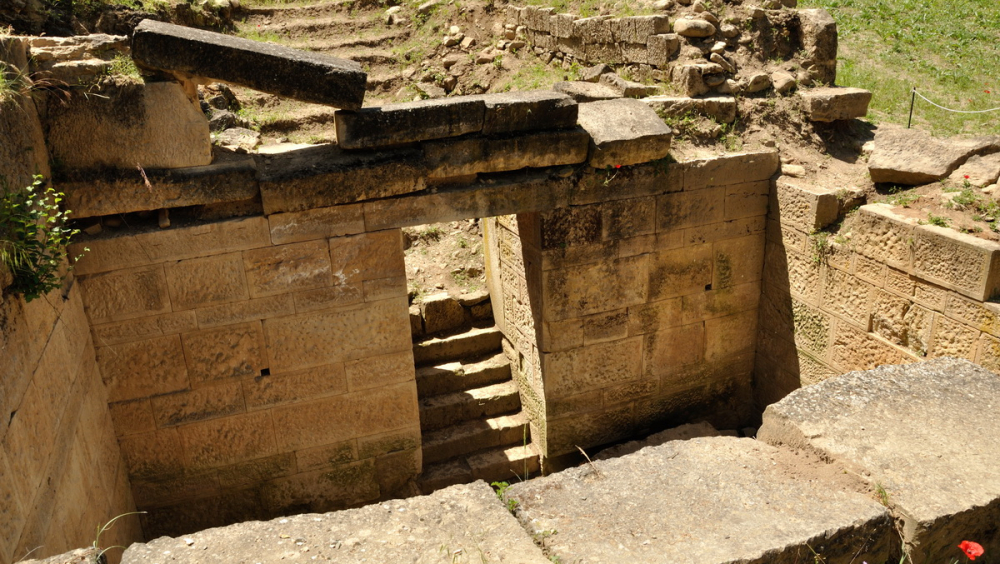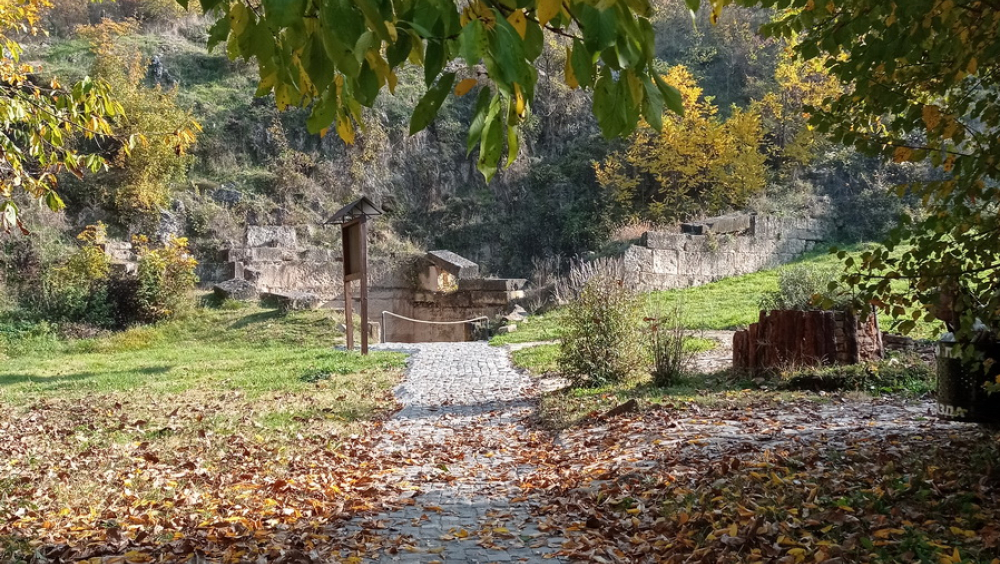Arheo Park Brazda – a link between the past and the future
This is a story about a very important and unique archaeological site, with a sad past but a very bright future. A story about the importance of hard work, unity, and sharing common values and visions. A tale of a successful collaboration between young archeologists and the local community to a common goal, to protect the cultural heritage that we all share.
This story begins in the distant 1986 in a small but ancient country in the central Balkans. A country, full of invaluable cultural heritage, 5000 and more archaeological sites, and most importantly, warm and welcoming people.
Archaeologists working in a small village in the vicinity of Skopje, the state capital, stumbled upon a once-in-a-lifetime discovery. In front of them emerged a monumental tomb worthy of a king. A beautiful, unique architectural edifice that probably was built for one of the most important people of the Paeoninas, the tribe that lived on this territory in the 5th and 4th century B.C.
The news of the discovery of this “Royal Tomb” echoed through the professional circles and through the media of the time. It was mentioned as one of the most important discoveries on the wider Balkan Peninsula, but unfortunately, everything stopped there. For the next several decades it was completely forgotten and left to the mercy of time.
Even though the relevant institutions had forgotten about this unique and important monument, in the mind of the young and ambitious archaeology students (that we were at the time) the sad “destiny” of this site was unacceptable. We knew where it is, but the entrance to it was nearly impossible and the whole place was overgrown with wild vegetation and buried under years and years of piled garbage. Signposts and information panels were nonexistent, so the visitors can neither be led to nor informed about the immense historical heritage that they were unknowingly passing by. The general public was completely unaware of its existence and more importantly, so was the world.
We formed an association with a clear goal to protect and promote cultural heritage. It was the first one of its kind in our country and it consisted of experienced archaeologists and students whose goals were to contribute to the development of archaeology in general and present it before the wider public.
Then the idea to turn this place into a tourist attraction and the first archaeological park in our country was born. After many years and many attempts to realize this wishful idea, in 2012 we finally started the project.
When the work started the first reaction of the local population was that our efforts would be a waste of time and energy and that it is not possible to create an attraction on this spot because it is not that important and that nobody would come to see it. We immediately knew that it is really important to do this together with the local community. In order to change the opinion of the locals, during our work there we changed our approach. Rather than excluding them from the project, we tried to engage their interest primarily through education.
We tried to explain the special connection that we have with this particular cultural heritage, we told them the whole story about this site in a simple and understandable language hoping that we can convey the uniqueness and importance of this Royal tomb.
After this, the interest in the site increased, and the locals started to take their heritage as a value that must be preserved. We were happy that we've managed to inspire in them a sense of personal responsibility to protect and safeguard this unique monument. After all, it was in their village, left there by their ancestors.
All these actions were altogether beneficial as the local citizens who at the beginning did not want to have anything with the project, changed their opinion and started supporting us. The help came in many ways, some of them helped with physical work, others were bringing tools and equipment, locals that worked in the municipality were helping with bureaucracy, etc. The involvement of the locals inspired many others from the surrounding villages to show interest in the project and for a very short time, respectful numbers of the inhabitants were contributing in some way. After gaining the trust and support from the locals, everything was running smoothly.
The interior of the tomb and the passageway (dromos) were completely cleaned from wild vegetation and debris which increased the visibility of the site; we provided an approach to the site by building an access path with two wooden bridges; the plateau in front of the tomb was cleared and leveled; the riverbeds were cleaned of garbage with a big voluntary action where on our surprise more than 30 people showed up; a small square was built and wooden benches with trash cans were placed; the landscape around the park was horticulturally refined; information panels and signposts were placed and informative flyers were printed and distributed. We paid particular attention to using natural materials that do not stand out from their surroundings. And finally, the opening of the Arheo Park was covered by all the media, and a website about the park was developed (www.arheoparkbrazda.mk).
We were proud of our work, and so were the others. We made it! We made this new tourist attraction, the first archaeological park in our country all by ourselves. And then the institutions have finally heard us.
Since then our organization in partnership with the Archaeological Museum and with the support of the Ministry of Culture is taking care of this site by providing regular maintenance of the park as well as enriching it with new features. In the area of promotion and popularization, we’ve done a lot by producing several documentary films and promotional videos which were screened on different events throughout our country and abroad, the web site and all the social media platforms are regularly updated with new information, photos and events and promotional material is being produced regularly.
The interest in this cultural monument significantly increased after mounting the signposts and the official opening of the “Arheo Park Brazda”. Apart from casual passersby that would learn about this place from the signpost, organized groups also visit the park. As the local inhabitants inform us, the site receives daily visits from foreign and domestic tourists who are in awe of everything this site has to offer from a cultural aspect as well as from the natural beauties that abound. The undertakings so far are just a part of the overall conceptual solution of the arheo park. Due to the heightened interest in the park, as well as the increased number of visitors a second phase of the project is planned that would include: building access paths to the top of the hill where the ancient town stood, setting up a wooden gazebo which would serve as an educational nest for the students of archaeology and the pupils from the primary schools located in the vicinity of the site as well for larger groups of tourists.
In 2018 as part of the celebration of the European year of cultural heritage, the EU Info Center in Skopje supported the project “Promotion of the Royal tomb at the archaeological site Gradishte – Brazda”. The main goal this time was to raise awareness among the local community about the significance of this cultural monument that they have in their vicinity, to promote the site, as well as to encourage them to participate in the preservation and maintenance of the Arheo Park in the future.
As part of the project, we held lectures in the local primary school and the municipality office. We managed to stimulate interest among the children to deepen their knowledge about archaeology and the care of the cultural heritage. The employees of the municipality and the mayor, through the discussion that was held at the end of the lecture showed that they actually have many ideas on how to contribute to the promotion of this site and the future development of cultural and rural tourism in their municipality.
And finally, we organized an event on the archaeological site itself, open to everybody and dedicated to the local community, which is a rarity in our country. We invited everybody! We showed several documentary films, we made an exhibition “The Royal tomb from its discovery until today” we prepared a small cocktail, it was really fun and really rewarding to see how many people showed up. The event was made with a very important purpose – to explain to the locals that they are the ones who have an irreplaceable role in the maintenance of the cultural heritage in their village.
In the end, we can say that through the years we have developed a true partnership with the local community and we believe that together we will take good care of the archeological site and the park itself and that this beautiful place will become a very popular tourist attraction in the future.
We know that from someone’s perspective this could be seen as a small contribution to raising awareness about the protection of the cultural heritage, but we are sharing the same European visions and values and we hope for a bright future. Successful projects generally ‘start small’ but are conceived by people who ‘think big.’ During these 10 years, we’ve had some ups, a lot of downs but we’ve stood strong. We believe that we achieved the most important goal: we have brought the locals closer together, and we have brought theirs, but also our common heritage closer to their hearts.


